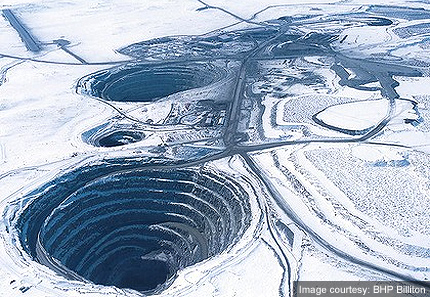diamond mines
 The Ekati diamond mine is located near Lac de Gras, is about 300 km north east of Yellowknife, Northwest Territories. To date 314ha of tundra habitat have been used for construction of the mine and 611ha of the total lease area of 10,960ha has been affected by the operation.
The Ekati diamond mine is located near Lac de Gras, is about 300 km north east of Yellowknife, Northwest Territories. To date 314ha of tundra habitat have been used for construction of the mine and 611ha of the total lease area of 10,960ha has been affected by the operation.
Volcanic pipes are formed by deep volcanoes that rush magma to the surface from deep within the earth's mantle where it solidifies into either kimberlite or lamproite, both heavy with magnesium. Kimberlite is where diamonds, garnets, spinels and peridots are found, formed by carbon under extreme heat and pressure.
The volcanic pipe that indicates kimberlite at Ekati was discovered by geologists Charles E Fipke and Dr Stewart E Blusson who have a 10% holding in the mine. BHP Billiton, which held the rest, has recently sold it to Harry Winston Diamond Corp, a partner with Diavik Diamond Mines, a subsidiary of Rio Tinto.
From The Province in 2010: 'Much of the aboriginal employment at Ekati is a result of impact-benefit agreements signed with four First Nations, Metis and Inuit communities whose traditional territories are located around the mine site. The confidential IBAs – which were signed before construction began at the mine – includes agreements on preferential hiring, cash payments, scholarship funding, business opportunities and travel to and from the community and Ekati.'
Well then. This was Diefenbaker's dream, that northern development would be the saving of Canada. And as the north is aboriginal, it is seen as the saving of First Nations, Metis and Inuit – a source of revenue and employment. However, rarely are any of these mines Canadian-owned. We are merely the hewers of wood, drawers of water and miners of resources. The big benefits are exported with the diamonds, or oil, or whatever it is.
